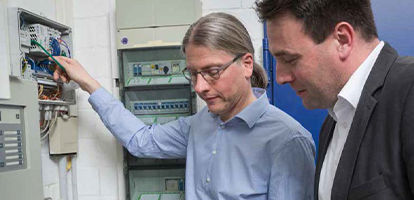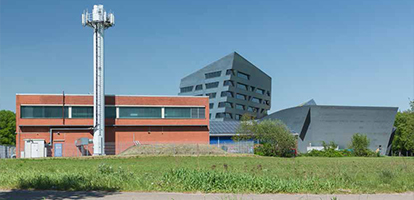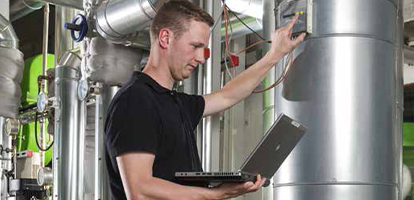



Sector coupling, digitization and customer orientation – these are the focuses of the energy service provider Avacon Natur. This focus increases the efficiency of the energy systemsand district heating systems and provides demand-driven information. Above all, sector coupling – integrated control for heat, electrical and electromobility – requires digital data collection.
“Digitization is the glue that holds sector coupling together and makes efficient solutions for neighborhoods and districts possible,” says Andreas Klesse, Board Member of Avacon Natur GmbH. The company is a subsidiary of the regional energy service provider Avacon AG – itself a part of E.ON – and operates CHP plants, heating networks, heating service systems and a wide range of renewable energy systems in Saxony-Anhalt, Lower Saxony, North Rhine-Westphalia and Hesse. It currently has 80 employees and is on a course for further growth.
The Energy Transition Will Be Driven by Customers
After the first phase of the energy transition, which mostly took place in the electricity sector and focused on the expansion requirements of renewable energies, the second phase will be driven by customers – and their needs are changing. Customers are increasingly becoming prosumers and playing an active role in the energy system. This shifts the challenge from pure energy supply to integrated solutions for heating, electricity and electromobility.
Innovative energy solutions can be implemented especially efficiently for development of new residential and business districts. Such development allows an integrative view of the energy requirements during the planning phase already, which allows the energy supply of a district to be optimized. Nonetheless, Avacon Natur implements these solutions for both new construction and existing districts.
The challenge is coordinating the supply of electricity, as well as heat from CHP plants, photovoltaic plants and other heat producers, with customer demand in the district. This requires precise data to be collected and processed digitally. The system distribution boxes from WAGO that Avacon Natur uses for this purpose are ideal for the data gathering.
Climate-Friendly Energy Solutions
In the Salzwedel metropolitan area, the company is already testing such climate-friendly energy solutions. Avacon Natur operates a complex power generation structure there, with combined heat and power (CHP) plants, photovoltaic systems and power-to-heat plants. A combination of centralized and decentralized heat generation is implemented here successfully. The residents also benefit, since so-called tenant electricity models make cost-optimized power supply possible for them. Furthermore, smaller CHP plants are connected to the Salzwedel district heating grid and provide electricity and heat efficiently in combination with a photovoltaic system. Surplus generated heat is fed into the existing heating network.
Digitization of the Heating Network
Digitization is advancing in existing systems too. The focus here is on increasing the efficiency of the district heating network. Avacon Natur is currently equipping about 100 energy systems with WAGO system distribution boxes for data collection. One of them, in the Bockelsberg district of Lüneburg, supplies heat to Leuphana University and an adjacent residential district and cold air to the main auditorium building of the university for the server rooms and air-conditioning the lecture halls. The Avacon local heating network at this site consists of three sub-networks and is 2 miles (3.3 km) long. It includes 55 transmission stations in the residential neighborhood and a central heat transfer point for the university. The downstream network on the campus is the responsibility of Leuphana University.
The sub-networks are operated at different flow temperatures. The CHPs installed there are the heart of the heat generation and are supplied with renewable energy in the form of biogas. Digitization of the heating network should allow them to fully exploit their heat/power coupling potential through even more intelligent operation. Running the motors up and down frequently negatively impacts the service life and efficiency. Digitization can fix that too.
Added Value through the Cloud
“If we know what temperatures are effectively present in the network, we can control the CHP plants more efficiently,” explains Andreas Klesse. Therefore, Avacon Natur couples the network temperature data to the forecast profiles and the data from the district heating station. Here the WAGO system distribution box collects all the important values such as the heat quantities, flow rates and supply and return temperatures. The motor data of the CHP plants is added to this.
A central component of the specialized WAGO system distribution box is the PFC200 controller. It comprises a power supply, a circuit breaker, 16 digital inputs, four analog inputs, an M-Bus master module and transfer terminals blocks for the sensors and actuators. An SD card slot is also available, making software updates very straightforward, for example. This system distribution box configuration ensures that one piece of hardware meets all the requirements of the various Avacon Natur energy systems. “The WAGO system distribution box made according to our specifications, the Avacon Natur Cloud Box, offers us a tailored solution, which is still scaleable at will,” says Lars Baumann, Team Leader of Asset Management at Avacon Natur.
Besides the specialized hardware, WAGO created a CODESYS application on the basis of Avacon Natur’s specifications. This allows the connection of M-Bus meters to be configured via the Web interface of the PFC200 and the digital inputs to be configured as pulse counter inputs or fault message inputs. Avacon Natur’s team of measurement and control technology experts handles installation and commissioning. Jörn von Hörsten, a member of this team, adds: “The Web interface is enormously practical, especially during commissioning. It provides an immediate overview of how the energy data is sent to the cloud environment.”
Programming Freedom, Maximum Security
The industry standard, support for open protocols, fieldbus independence and the flexibility of CODESYS programming freedom were additional points in favor of the WAGO system. “In addition to collecting data through open interfaces, the WAGO system also makes it possible for us to model technical control and regulation functions,” says Baumann. “In WAGO, we found a strong partner with which we can collaborate on further development of our projects and the ideal programming for them,” emphasizes Klesse.
For the initial data analysis of its energy systems and heating networks, Avacon Natur uses WAGO Cloud Data Control, which is based on the Microsoft Azure cloud computing platform. This allows not only asset management employees at company headquarters, but also the distributed employees throughout the system, to examine the data of all the energy systems at any time. WAGO Cloud Data Control stores all the measurement data and serves as the interface to Avacon Natur’s existing energy data management system, which also runs on the MS Azure platform. This energy data management system performs automatic plausibility checks of the meter readings, monitors the efficiency of the energy systems and is used for reporting.
Besides functional aspects, it also illuminates security issues. The hardened firmware and the encryption of all data practically rule out third-party access to the data in the cloud.
Forecast-Based Network Control
In Bockelsberg, Avacon Natur is also conducting a pilot project to test to what degree weather forecasts can increase the efficiency of the heating network. The load profile of the coming day is forecast on the basis of historical load profiles and the weather conditions, and the heat generation is adjusted accordingly. The storage management is optimized in combination with a thermal energy storage system to cap the temporary load peaks – always with the goal of maximizing the cogeneration potential.
However, Avacon is looking even further into the future with the forecast-based method and will also incorporate electricity market data into the optimization process, since such methods are necessary in order to integrate distributed heat generators that fluctuate in time, such as solar thermal collectors and power-to-heat plants or industrial waste heat, into a heating network.
Besides sector coupling in new districts and increasing efficiency in existing systems, Board Member Andreas Klesse also cites a further motivation for digitizing heating networks: This makes is possible to provide certain data to customers. For example, housing companies can handle tenant billing quickly and reliably.
Text: LARS KUEHN, WAGO
Photos: DIRK EISERMANN